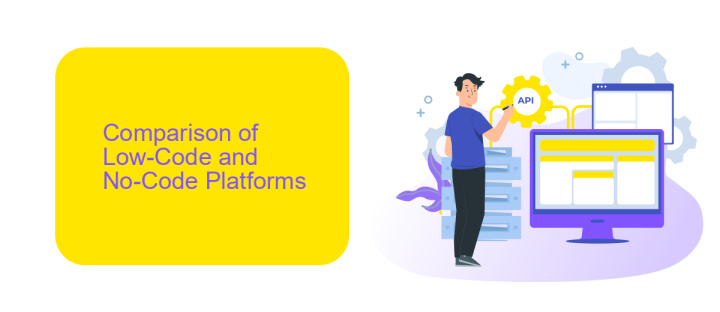Top 10 Low-Code No-Code Platforms
In the rapidly evolving world of technology, low-code and no-code platforms are revolutionizing the way businesses build applications. These tools empower users with little to no programming experience to create functional and sophisticated software solutions. Here, we present the top 10 low-code and no-code platforms that are driving innovation and efficiency across various industries.
Introduction
In today’s fast-paced digital world, businesses are constantly seeking ways to streamline their operations and accelerate their development processes. Low-code and no-code platforms have emerged as powerful solutions, enabling even those with minimal technical expertise to create robust applications. These platforms are revolutionizing the way organizations approach software development, making it more accessible and efficient.
- Ease of use: No need for extensive coding knowledge.
- Cost-effective: Reduces the need for hiring specialized developers.
- Rapid development: Speeds up the application creation process.
- Flexibility: Adaptable to various business needs.
- Integration capabilities: Easily integrates with existing systems and services.
One notable service that enhances the integration capabilities of low-code and no-code platforms is ApiX-Drive. This tool simplifies the process of connecting different applications and automating workflows, further boosting productivity. By leveraging such platforms and services, businesses can stay competitive and agile in an ever-evolving technological landscape.
Comparison of Low-Code and No-Code Platforms

Low-code and no-code platforms have revolutionized the way businesses develop applications. Low-code platforms provide a more flexible environment for developers by allowing them to write custom code when needed, thus offering greater control over the application's functionality. These platforms are ideal for more complex projects where specific customization is essential. On the other hand, no-code platforms are designed for non-technical users, enabling them to create applications using visual interfaces and pre-built templates without writing any code. This makes no-code platforms perfect for quickly developing simple applications and automating routine tasks.
When comparing the two, it's essential to consider the specific needs of your project. If your goal is to create a highly customized application with complex workflows, a low-code platform would be more suitable. However, for straightforward applications and rapid prototyping, no-code platforms offer a faster and more accessible solution. Tools like ApiX-Drive can further enhance the capabilities of both low-code and no-code platforms by providing seamless integrations with various services, allowing users to automate data transfer and streamline their workflows efficiently.
Features and Benefits of Top Low-Code No-Code Platforms

Low-code and no-code platforms are revolutionizing the way businesses develop applications by enabling users with minimal coding knowledge to create functional and scalable solutions. These platforms offer a range of features and benefits that cater to different business needs.
- Drag-and-Drop Interface: Simplifies the development process by allowing users to visually design their applications.
- Pre-built Templates: Speeds up development with ready-made templates for common use cases.
- Integration Capabilities: Platforms like ApiX-Drive facilitate seamless integration with various third-party services, enhancing functionality.
- Scalability: Ensures that applications can grow with the business, handling increased loads and users.
- Security Features: Provides robust security measures to protect sensitive data.
- Customizable Workflows: Allows for the creation of tailored workflows that meet specific business requirements.
- Collaboration Tools: Enables team collaboration, making it easier to manage projects and track progress.
- Cost-Effective: Reduces development costs by minimizing the need for specialized coding skills.
- Rapid Prototyping: Facilitates quick creation and testing of prototypes, accelerating time-to-market.
- Support and Community: Offers extensive support and a community of users to help troubleshoot and share best practices.
Overall, these features and benefits make low-code and no-code platforms an attractive option for businesses looking to accelerate their digital transformation efforts while maintaining flexibility and control over their applications.
Use Cases and Industries Served

Low-code and no-code platforms are versatile tools that cater to a wide range of use cases across various industries. These platforms enable businesses to streamline operations, enhance productivity, and reduce development time without requiring extensive coding knowledge. From automating workflows to creating custom applications, the possibilities are vast.
Industries such as finance, healthcare, retail, and education have significantly benefited from these platforms. For instance, in the finance sector, these tools can automate routine tasks like data entry and reporting. In healthcare, they help in managing patient records and scheduling appointments efficiently. Retail businesses use them to create personalized shopping experiences, while educational institutions leverage them for developing interactive learning modules.
- Automating business workflows and processes
- Developing custom applications and software solutions
- Managing customer relationships and support systems
- Integrating various services and APIs, such as ApiX-Drive, to streamline data flow
- Creating interactive dashboards and reporting tools
By leveraging low-code and no-code platforms, businesses can quickly adapt to changing market demands and improve their overall efficiency. These platforms democratize software development, allowing non-technical users to contribute to digital transformation initiatives effectively.
Selection and Implementation Considerations
When selecting a low-code or no-code platform, it is crucial to assess the specific needs of your organization. Consider the complexity of the applications you intend to build, the technical skills of your team, and the level of customization required. Evaluate the platform's scalability, security features, and integration capabilities with existing systems. A platform like ApiX-Drive can be invaluable for setting up seamless integrations, allowing you to connect various applications and automate workflows efficiently.
Implementation should be approached strategically. Start with a pilot project to understand the platform's strengths and limitations. Train your team thoroughly to maximize the platform's potential and ensure they are comfortable with the new tools. Monitor and evaluate the performance of the applications built, gathering feedback for continuous improvement. Leveraging platforms like ApiX-Drive during implementation can streamline processes and enhance the overall effectiveness of your low-code or no-code solutions.
FAQ
What is a low-code/no-code platform?
How do low-code/no-code platforms benefit businesses?
Can low-code/no-code platforms handle complex integrations?
Are low-code/no-code platforms secure?
What types of applications can be built with low-code/no-code platforms?
Apix-Drive is a universal tool that will quickly streamline any workflow, freeing you from routine and possible financial losses. Try ApiX-Drive in action and see how useful it is for you personally. In the meantime, when you are setting up connections between systems, think about where you are investing your free time, because now you will have much more of it.

